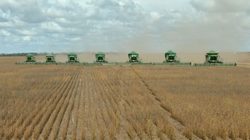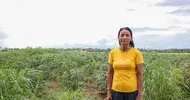Chain Reaction Research | 2 October 2018
Cerrado deforestation disrupts water systems, poses business risks for soy producers
Cerrado deforestation disrupts water systems, poses business risks for soy producers
The Cerrado biome, covering over 20 percent of Brazil’s terrain, is a savannah region with high biodiversity and an important function for the water systems in Brazil. The region has experienced significant soy expansion during the last two decades. Soy expansion has been most prevalent in Matopiba, consisting of the states of Maranhão, Tocantins, Piauí and Bahia. This paper analyses the impacts of the soy sector on deforestation and water availability, and how water issues in turn can impact soy production. It investigates how the water impacts within the region may translate into business risks for soy companies operating in the Cerrado.
Key Findings
- Native Cerrado vegetation is crucial for Brazil’s water systems as it supports rainfall through evapotranspiration. The deep root system of native Cerrado vegetation maintains the water balance in the region and throughout Brazil. It feeds 8 out of the 12 different hydrological regions in the country.
- Agricultural expansion in the Cerrado has replaced native vegetation. Soy acreage in the Cerrado increased by 9.54 million hectares to nearly 10 percent of the total Cerrado region, resulting in 2.83 million hectares of deforestation between 2000 and 2017. Sixty-nine percent of all soy-driven deforestation occurred in Matopiba, which is often referred to as the “last soy frontier” in Brazil. Matopiba saw a total of 1.9 million hectares of deforestation during this period.
- Deforestation contributes to increased droughts and erratic river behavior. Deforestation facilitated an 8.4 percent drop in annual rainfall in the Cerrado over the last 30 years and more variable rainfall patterns, posing the possibility of productivity loss for crops planted.
- Limited rainfall and high evaporation may lead to sharp decreases in productivity. Most of the soy farms in Matopiba are rainfed. As a result, producers are exposed to adverse impacts of agricultural droughts. In both 2012/2013 and 2015/2016, these factors negatively affected soy production in Matopiba. During those years, soy yields were as much as 40 percent lower than they were in Brazil as a whole. Therefore, the meteorological impact of agricultural expansion may create operational risks for soy producers.
- Soy companies may become exposed to conflict over water with other users such as local communities. Pressure on water resources in the Cerrado region has increased tensions between farmers and local population. Factors that contribute to heightened conflict risks include water used for irrigation, reduced spring water levels and agrochemical pollution.
- Soy producers and farmland investors may face increasing risks from declining agricultural suitability of farmland in Matopiba. Climate variability negatively influences soy yields and profits and further lowers the projected productivity of land. This may decrease the value of farmland, and lead to the risk of stranded assets.













